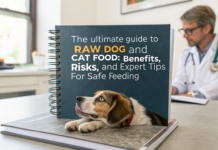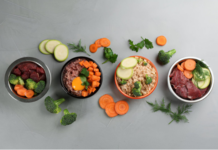Table of Contents
ToggleLast Updated on January 6, 2024 by Dogs Vets
Let’s face it, folks, our furry friends deserve the best. In the land of opportunity, that includes serving up meals fit for a four-legged champion.
But with shelves overflowing with kibble and cans claiming every health benefit under the sun, choosing the best dog food for American dogs can feel like navigating a canine culinary conundrum. Fear not, fellow dog lovers!
This comprehensive guide will be your compass, leading you through the maze of meaty morsels and grain-free goodies to find the perfect plate for your pup.
Tailoring Treats to Terrier Temperaments:
Before diving into specific brands, remember, one size doesn’t fit all paws. Your American pooch’s ideal diet depends on a tail-wagging variety of factors:
- Age: Pups need puppy power-packed formulas, while senior woofers require gentler fare for easy digestion.
- Breed: From the svelte Greyhound to the stout Bulldog, different breeds have different dietary needs. Consider your dog’s size, activity level, and any breed-specific sensitivities.
- Lifestyle: Does your dog hike the Appalachian Trail or lounge by the pool? Activity level plays a big role in calorie count and nutrient ratios.
- Health Concerns: Allergies, skin issues, or digestive quirks may necessitate specialized diets. Always consult your veterinarian for guidance.
Decoding Dog Food Jargon:
Now, let’s crack the code on those cryptic labels. Here’s a cheat sheet for deciphering the doggy dictionary:
- Protein: The MVP of dog food, providing energy and building muscle. Look for animal-based protein sources like chicken, beef, or lamb as the first few ingredients.
- Fat: Essential for healthy skin, coat, and energy, but keep an eye on the percentage to avoid packing on unwanted pounds.
- Carbohydrates: Fuel for Fido’s frolicking, but opt for complex carbs like sweet potatoes or brown rice over refined grains.
- Fiber: Aids digestion and keeps your pup feeling full.
- Vitamins & Minerals: The sprinkles on your dog’s sundae, ensuring overall health and vitality.
The All-Star Lineup: Top Dog Food Brands for American Dogs:
With your pup’s profile in mind, let’s explore some of the top contenders in the canine cuisine arena:
For the Active Adventurer:
- Purina Pro Plan Focus Large Breed Adult Dry Dog Food: Packed with protein and omega fatty acids, this formula fuels energetic explorations while supporting joint health in bigger breeds.
- Hill’s Science Diet Active Adult Dry Dog Food: Formulated for high-energy dogs, this kibble boasts lean protein and L-carnitine to keep your furry athlete performing at peak pup-tential.
For the Sensitive Soul:
- Royal Canin Small Breed Adult Dry Dog Food: Tailored for the delicate digestive systems of smaller breeds, this hypoallergenic recipe features prebiotics and easily digestible proteins.
- Blue Buffalo Sensitive Stomach Chicken & Brown Rice Recipe Dry Dog Food: Made with limited ingredients and natural flavors, this gentle formula soothes even the most finicky tummies.
For the Senior Sage:
- Hill’s Science Diet Adult 7+ Chicken & Brown Rice Recipe Dry Dog Food: Senior pups deserve special care, and this recipe delivers easily digestible nutrients, antioxidants, and joint support for a golden oldie glow.
- Iams ProActive Health Senior Dry Dog Food: Formulated with reduced protein and phosphorus, this food supports kidney health and keeps your older dog spry and spirited.
Beyond Kibble: Exploring Alternative Diets:
Not all good boys and girls go for the crunchy stuff. Let’s consider some alternative dietary paths:
- Wet Food: Packed with moisture and often higher in protein, wet food can be a great option for picky eaters or pups with dental issues.
- Raw Food: This diet mimics a dog’s natural prey, containing raw meat, bones, and vegetables. Consult your vet before embarking on this path, as proper handling and hygiene are crucial.
- Home-cooked Meals: While DIY dog food can be tempting, ensure you’re providing a complete and balanced diet with your vet’s guidance.
I’m eating a hot dog🤤🌭🤤 pic.twitter.com/8UZW9KUZYd
— Brianna🪐 (@timelesslyhntd) January 6, 2024
10 Facts About the Best Dog Food for American Pups 🇺🇸
Choosing the best dog food for your American canine companion can feel like navigating a jungle of kibble and cans. But fear not, fellow dog lovers! Unleash your inner dog-food detective with these 10 tail-wagging facts:
1. One Size Doesn’t Fit All Paws:
From the svelte Greyhound to the mighty Mastiff, each breed has unique dietary needs. Consider your dog’s size, activity level, and any breed-specific sensitivities when picking their perfect plate.
2. Protein is King (and Queen):
Look for animal-based protein sources like chicken, beef, or lamb near the top of the ingredient list. Protein fuels energy, builds muscle, and keeps Fido feeling full and satisfied.
3. Fat Matters, But Less is More:
Fat provides essential fatty acids for healthy skin and coat, but overdoing it can lead to unwanted pounds. Keep an eye on the fat percentage and adjust portions if needed.
4. Carbs Can Be Good Guys:
Not all carbs are created equal. Opt for complex carbs like sweet potatoes or brown rice over refined grains, which can spike blood sugar and contribute to weight gain.
5. Fiber Fills ‘Em Up:
Just like us, dogs need fiber for healthy digestion and a sense of fullness. Look for foods with moderate fiber content to keep your pup’s tummy happy.
6. Vitamins & Minerals: The Sprinkles on Your Dog’s Sundae:
These micronutrients ensure overall health and vitality. Look for complete and balanced formulas that meet your dog’s specific needs.
7. Age Matters, Adapt the Plate:
Pups need puppy-power formulas, while senior woofers require gentler fare for easy digestion. Choose a food specifically formulated for your dog’s life stage.
8. Beyond Kibble: Explore Wet, Raw, and Home-Cooked Options:
Not all good boys and girls love the crunch. Consider wet food, raw diets, or even home-cooked meals (with your vet’s guidance) to find the perfect fit for your dog’s preferences and health needs.
9. Treats are Tasty, Not a Meal Replacement:
Occasional rewards are fantastic, but remember, treats should be just that – treats! Stick to healthy options like freeze-dried meat or homemade apple chips to avoid packing on unnecessary pounds.
10. Consult Your Vet, They’re the Canine Cuisine Captain:
When in doubt, your vet is your best resource. They can help you navigate specific health concerns, choose the right food for your dog’s unique needs, and monitor their progress for optimal health and happiness.
Remember, your American dog deserves the best.
With these ten facts as your guide, you can confidently navigate the dog food jungle and find the perfect plate to fuel your furry friend’s adventures from sea to shining sea. Now go forth and unleash the happy, healthy pup within! 🇺🇸
Remember, You’re the Culinary Captain:
Ultimately, the best dog food for your American canine is the one that meets their individual needs and keeps them tail-waggingly happy and healthy.
So, experiment, observe, and consult your vet to create a custom culinary concoction that fuels your furry friend’s adventures from sea to shining sea.
Bonus Tip: Treats are fantastic for training and bonding, but remember, they should be occasional rewards, not meal replacements. Stick to healthy options like freeze-dried meat or homemade apple chips.
FAQ’S
Can I feed my American dog human food?
While occasional bites of unseasoned fruits, vegetables, and lean proteins are okay, human food often lacks the balanced nutrients dogs need. Always consult your vet before introducing human food to your dog’s diet.
What should I do if my dog has allergies or food sensitivities?
Look for dog food brands that use limited ingredients and hypoallergenic proteins. Consult your vet for a proper diagnosis and dietary recommendations.
How much should I feed my dog?
Feeding guidelines vary based on your dog’s age, breed, activity level, and health. Refer to the packaging instructions and adjust portions as needed based on your dog’s weight and body condition.
Is raw food safe for my dog?
While raw food can offer certain benefits, it also carries risks like bacterial contamination and nutritional imbalances. Consult your vet to ensure proper handling and supplementation if you choose a raw diet.
How often should I switch my dog’s food?
Sudden dietary changes can upset your dog’s stomach. If you need to switch foods, do so gradually over a 7-10 day period, mixing increasing amounts of the new food with the old.
Let me know what you think!
Fact Check
We strive to provide the latest valuable information for pet lovers with accuracy and fairness. If you would like to add to this post or advertise with us, don’t hesitate reach us. If you see something that doesn’t look right, contact us!
![Unleashing the Best Dog Food for American Dogs [+ 10 Facts to Know] Unleashing the Best Dog Food for American Dogs [+ 10 Facts to Know]](https://dogsvets.com/wp-content/uploads/2024/01/Screen-Shot-2024-01-05-at-12.57.44-AM-696x460.png)
















